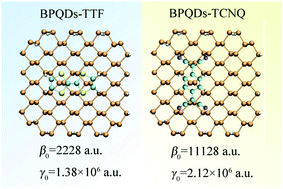Tuning the electronic and nonlinear optical properties of black phosphorus quantum dots by introducing electron-donating/withdrawing molecules (TTF/TCNQ)
Abstract
Two novel complexes were constructed by adsorption of two typical organic molecules, including one electron-donating molecule (TTF = tetrathiafulvalene) and one electron-withdrawing molecule (TCNQ = tetracyanoquinodimethane), on the surface of black phosphorus quantum dots (BPQDs). There exist considerable charge transfer and strong non-covalent interaction between organic molecules and BPQDs. The results of density functional theory (DFT) calculations show that the static first and second hyperpolarizabilities can be significantly enhanced by introducing TTF/TCNQ groups on BPQDs. Apart from static nonlinearity, hyper-Rayleigh scattering (HRS) first hyperpolarizability shows a remarkable value at a dispersion frequency of 1907 nm. Besides, the frequency-dependent first hyperpolarizability increases significantly while going from the gas to solvent phase. BPQDs–TTF presents a strong dipolar character, whereas BPQDs–TCNQ presents a relatively larger octupolar behavior. Compared with BPQDs–TTF, BPQDs–TCNQ exhibits better stability and larger first hyperpolarizability. This work highlights the superiority of combining TCNQ and BPQDs to construct high-performance nonlinear optical (NLO) molecules.



 Please wait while we load your content...
Please wait while we load your content...